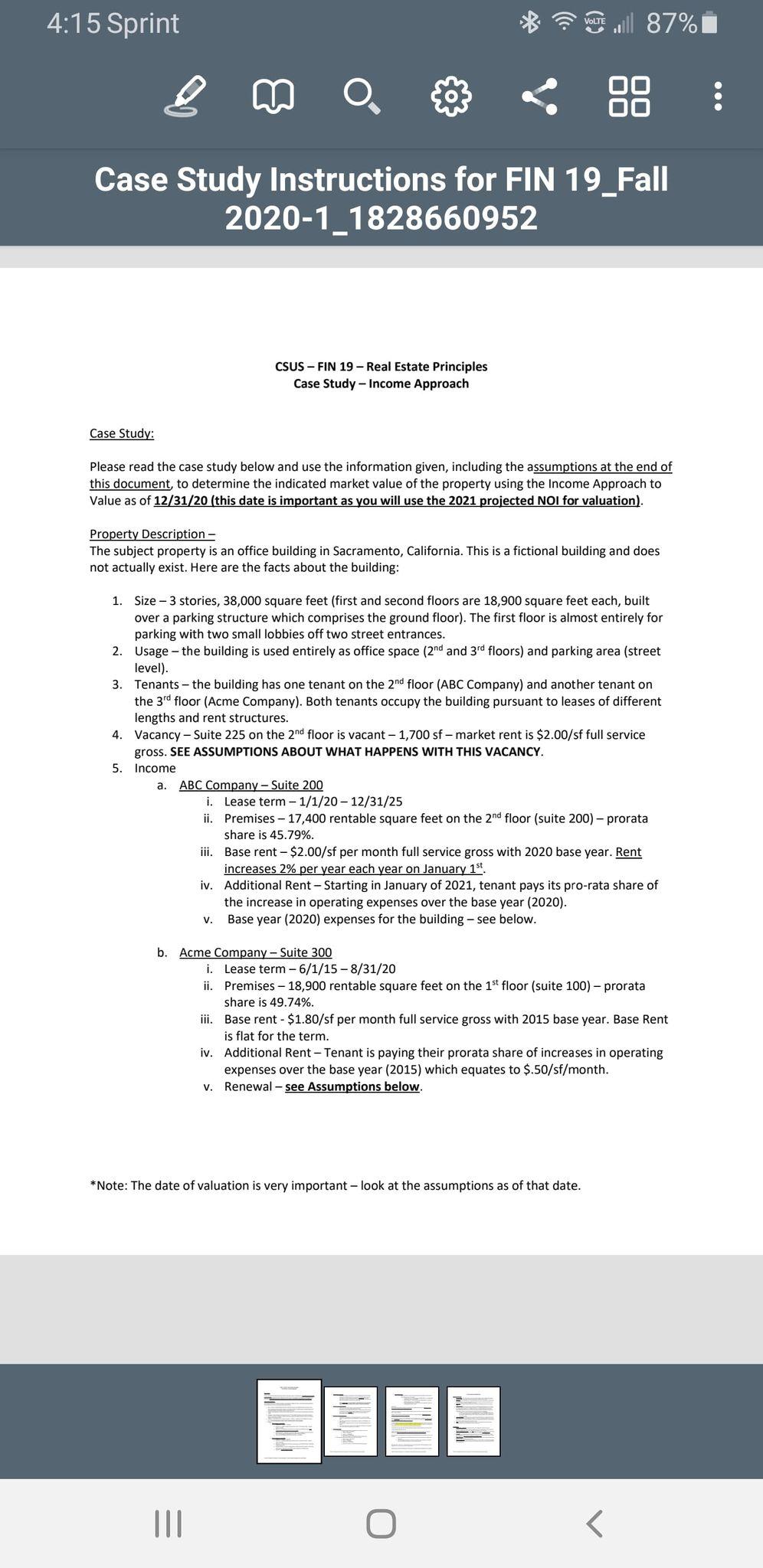
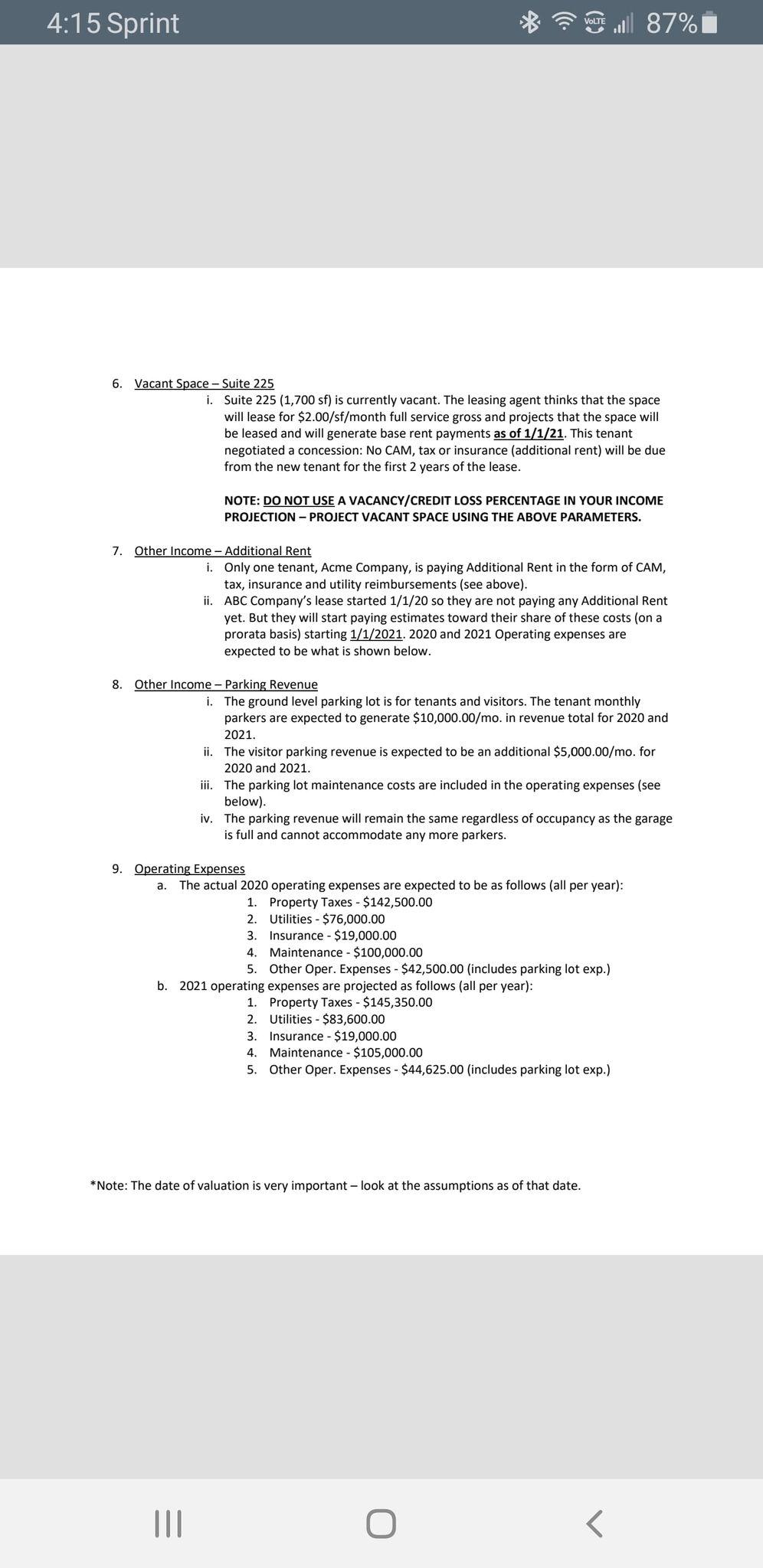
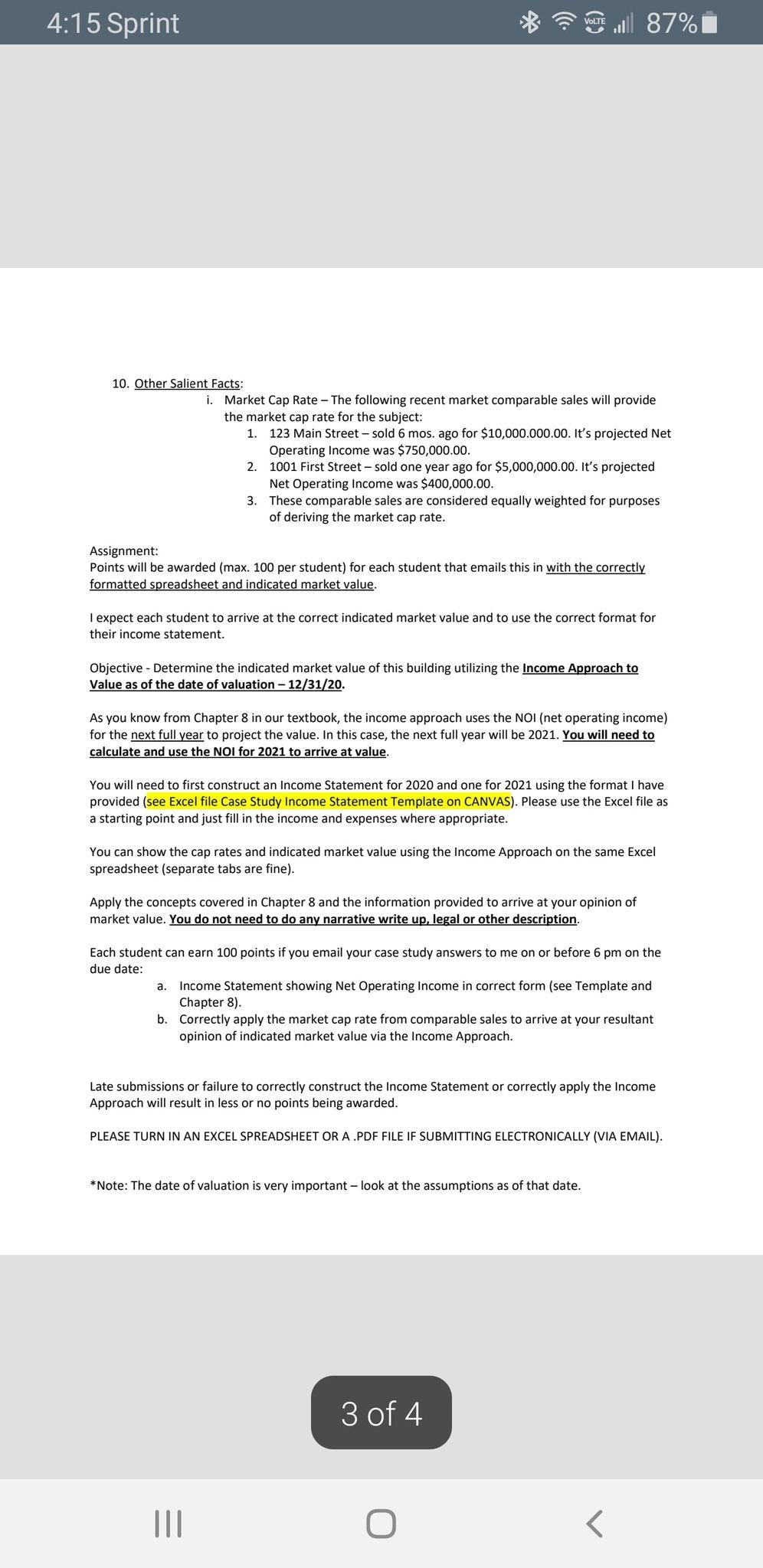
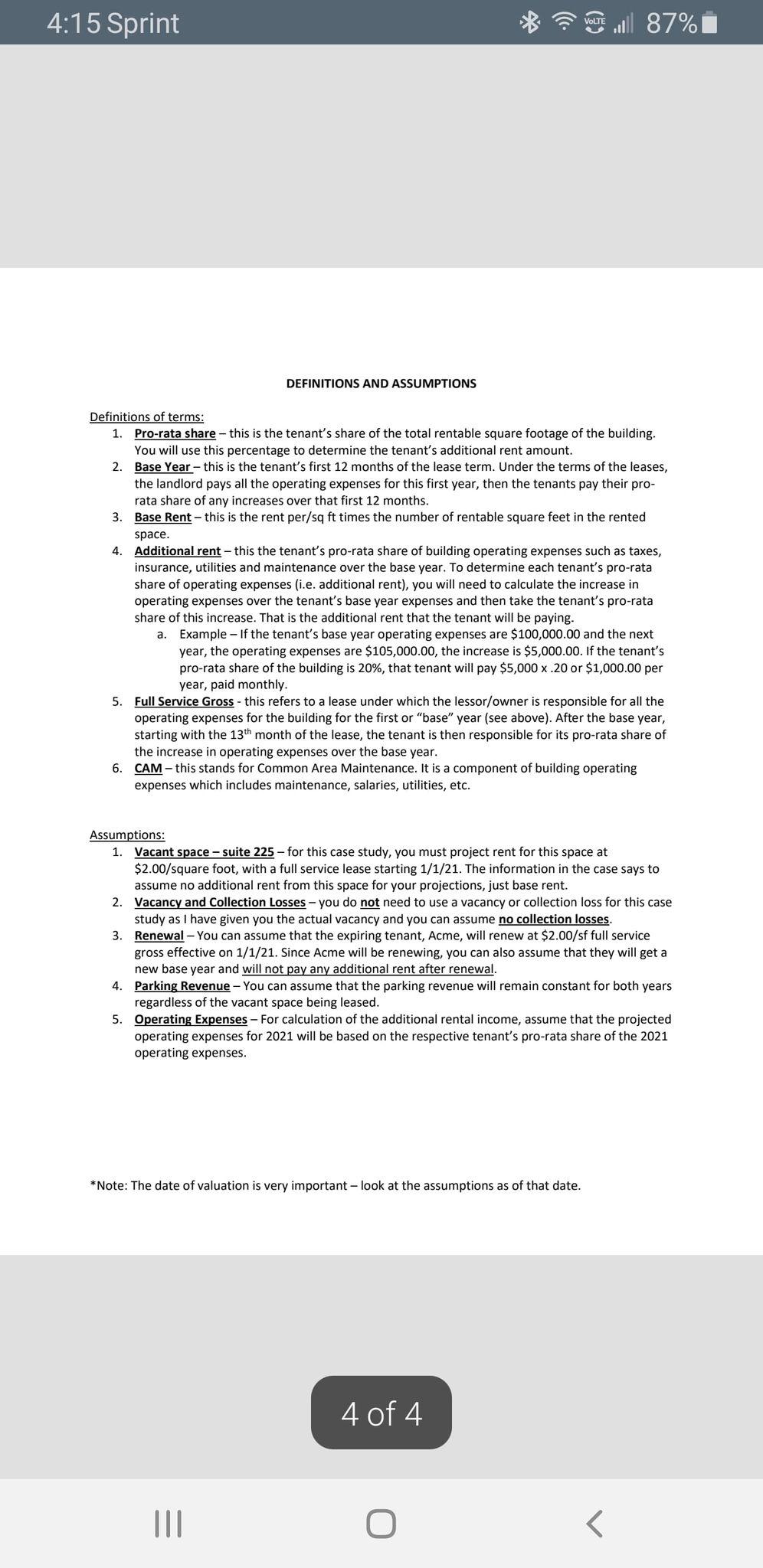
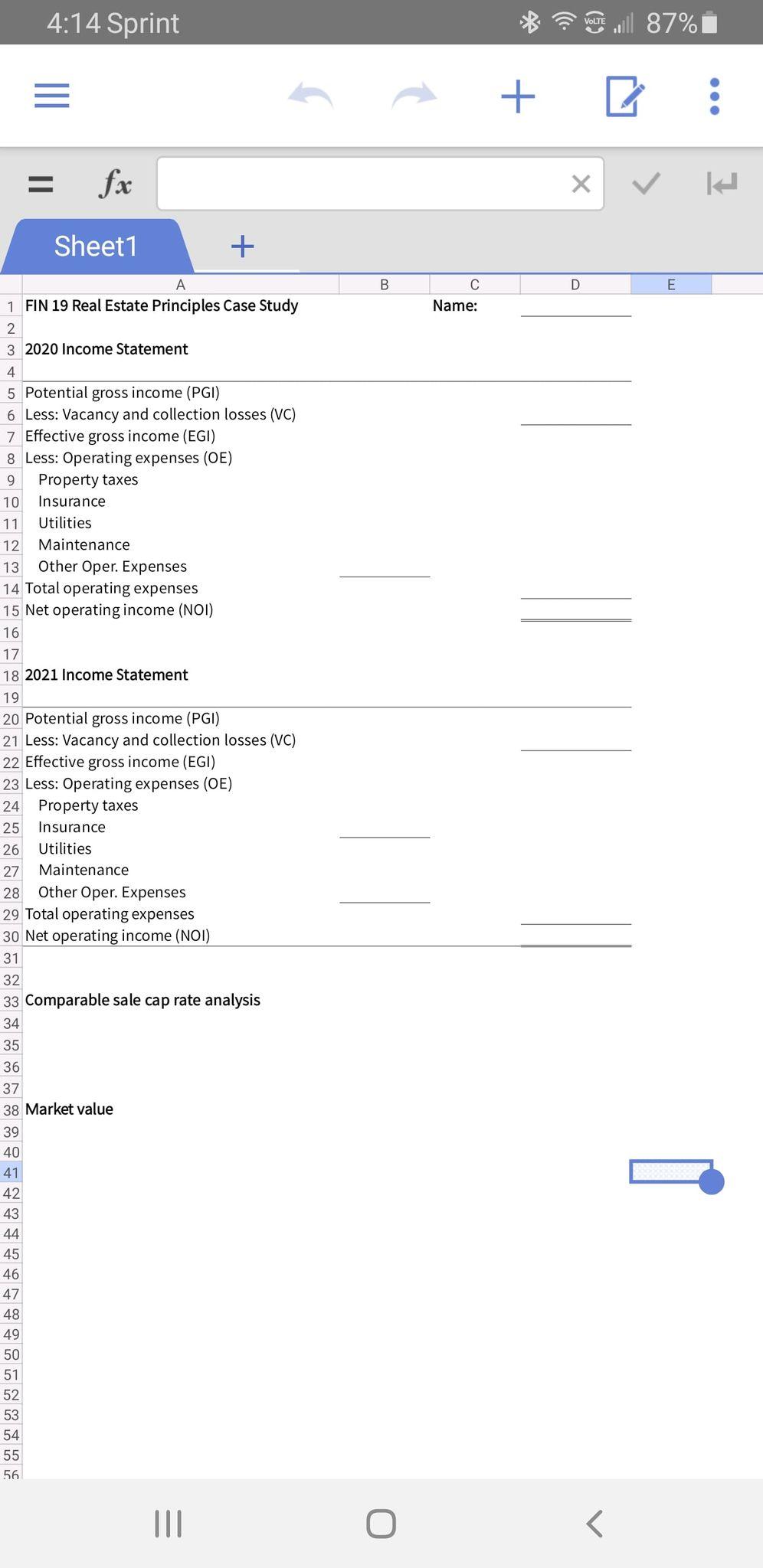
| FIN 19 Real Estate Principles Case Study | | Name: | |
| | | | |
| 2020 Income Statement | | | |
| | | | |
| Potential gross income (PGI) | | | |
| Less: Vacancy and collection losses (VC) | | | |
| Effective gross income (EGI) | | | |
| Less: Operating expenses (OE) | | | |
| Property taxes | | | |
| Insurance | | | |
| Utilities | | | |
| Maintenance | | | |
| Other Oper. Expenses | | | |
| Total operating expenses | | | |
| Net operating income (NOI) | | | |
| | | | |
| | | | |
| 2021 Income Statement | | | |
| | | | |
| Potential gross income (PGI) | | | |
| Less: Vacancy and collection losses (VC) | | | |
| Effective gross income (EGI) | | | |
| Less: Operating expenses (OE) | | | |
| Property taxes | | | |
| Insurance | | | |
| Utilities | | | |
| Maintenance | | | |
| Other Oper. Expenses | | | |
| Total operating expenses | | | |
| Net operating income (NOI) | | | |
| | | | |
| | | | |
| Comparable sale cap rate analysis | | | |
| | | | |
| | | | |
| | | | |
| | | | |
| Market value | | | |
4:15 Sprint . 87% I Case Study Instructions for FIN 19_Fall 2020-1_1828660952 CSUS - FIN 19 - Real Estate Principles Case Study -Income Approach Case Study: Please read the case study below and use the information given, including the assumptions at the end of this document, to determine the indicated market value of the property using the Income Approach to Value as of 12/31/20 (this date is important as you will use the 2021 projected NOI for valuation). Property Description - The subject property is an office building in Sacramento, California. This is a fictional building and does not actually exist. Here are the facts about the building: 1. Size - 3 stories, 38,000 square feet (first and second floors are 18,900 square feet each, built over a parking structure which comprises the ground floor). The first floor is almost entirely for parking with two small lobbies off two street entrances. 2. Usage - the building is used entirely as office space (2nd and 3rd floors) and parking area (street level). 3. Tenants - the building has one tenant on the 2nd floor (ABC Company) and another tenant on the 3rd floor (Acme Company). Both tenants occupy the building pursuant to leases of different lengths and rent structures. 4. Vacancy - Suite 225 on the 2nd floor is vacant - 1,700 sf - market rent is $2.00/sf full service gross. SEE ASSUMPTIONS ABOUT WHAT HAPPENS WITH THIS VACANCY. 5. Income ABC Company - Suite 200 i. Lease term - 1/1/20 - 12/31/25 ii. Premises - 17,400 rentable square feet on the 2nd floor (suite 200) - prorata share is 45.79%. iii. Base rent - $2.00/sf per month full service gross with 2020 base year. Rent increases 2% per year each year on January 1st iv. Additional Rent - Starting in January of 2021, tenant pays its pro-rata share of the increase in operating expenses over the base year (2020). V. Base year (2020) expenses for the building - see below. a. b. Acme Company - Suite 300 i. Lease term - 6/1/15 - 8/31/20 ii. Premises - 18,900 rentable square feet on the oor (suite 100) - prorata share is 49.74%. iii. Base rent - $1.80/sf per month full service gross with 2015 base year. Base Rent is flat for the term. iv. Additional Rent - Tenant is paying their prorata share of increases in operating expenses over the base year (2015) which equates to $.50/sf/month. v. Renewal - see Assumptions below. *Note: The date of valuation is very important-look at the assumptions as of that date. III T 4:15 Sprint . 87% 6. Vacant Space - Suite 225 i. Suite 225 (1,700 sf) is currently vacant. The leasing agent thinks that the space will lease for $2.00/sf/month full service gross and projects that the space will be leased and will generate base rent payments as of 1/1/21. This tenant negotiated a concession: No CAM, tax or insurance (additional rent) will be due from the new tenant for the first 2 years of the lease. NOTE: DO NOT USE A VACANCY/CREDIT LOSS PERCENTAGE IN YOUR INCOME PROJECTION - PROJECT VACANT SPACE USING THE ABOVE PARAMETERS. 7. Other Income - Additional Rent i. Only one tenant, Acme Company, is paying Additional Rent in the form of CAM, tax, insurance and utility reimbursements (see above). ii. ABC Company's lease started 1/1/20 so they are not paying any Additional Rent yet. But they will start paying estimates toward their share of these costs (on a prorata basis) starting 1/1/2021. 2020 and 2021 Operating expenses are expected to be what is shown below. 8. Other Income - Parking Revenue i. The ground level parking lot is for tenants and visitors. The tenant monthly parkers are expected to generate $10,000.00/mo. in revenue total for 2020 and 2021. ii. The visitor parking revenue is expected to be an additional $5,000.00/mo. for 2020 and 2021. iii. The parking lot maintenance costs are included in the operating expenses (see below). iv. The parking revenue will remain the same regardless of occupancy as the garage is full and cannot accommodate any more parkers. 9. Operating Expenses a. The actual 2020 operating expenses are expected to be as follows (all per year): 1. Property Taxes - $142,500.00 2. Utilities - $76,000.00 3. Insurance - $19,000.00 4. Maintenance - $100,000.00 5. Other Oper. Expenses - $42,500.00 (includes parking lot exp.) b. 2021 operating expenses are projected as follows (all per year): 1. Property Taxes - $145,350.00 2. Utilities - $83,600.00 3. Insurance - $19,000.00 4. Maintenance - $105,000.00 5. Other Oper. Expenses - $44,625.00 (includes parking lot exp.) *Note: The date of valuation is very important-look at the assumptions as of that date. III o 4:15 Sprint . 87% 10. Other Salient Facts: i. Market Cap Rate - The following recent market comparable sales will provide the market cap rate for the subject: 1. 123 Main Street - sold 6 mos. ago for $10,000.000.00. It's projected Net Operating Income was $750,000.00. 2. 1001 First Street - sold one year ago for $5,000,000.00. It's projected Net Operating Income was $400,000.00. 3. These comparable sales are considered equally weighted for purposes of deriving the market cap rate. Assignment: Points will be awarded (max. 100 per student) for each student that emails this in with the correctly formatted spreadsheet and indicated market value. I expect each student to arrive at the correct indicated market value and to use the correct format for their income statement. Objective - Determine the indicated market value of this building utilizing the Income Approach to Value as of the date of valuation - 12/31/20. As you know from Chapter 8 in our textbook, the income approach uses the NOI (net operating income) for the next full year to project the value. In this case, the next full year will be 2021. You will need to calculate and use the NOI for 2021 to arrive at value. You will need to first construct an Income Statement for 2020 and one for 2021 using the format I have provided (see Excel file Case Study Income Statement Template on CANVAS). Please use the Excel file as a starting point and just fill in the income and expenses where appropriate. You can show the cap rates and indicated market value using the Income Approach on the same Excel spreadsheet (separate tabs are fine). Apply the concepts covered in Chapter 8 and the information provided to arrive at your opinion of market value. You do not need to do any narrative write up, legal or other description. Each student can earn 100 points if you email your case study answers to me on or before 6 pm on the due date: a. Income Statement showing Net Operating Income in correct form (see Template and Chapter 8). b. Correctly apply the market cap rate from comparable sales to arrive at your resultant opinion of indicated market value via the Income Approach. Late submissions or failure to correctly construct the Income Statement or correctly apply the Income Approach will result in less or no points being awarded. PLEASE TURN IN AN EXCEL SPREADSHEET OR A.PDF FILE IF SUBMITTING ELECTRONICALLY (VIA EMAIL). *Note: The date of valuation is very important-look at the assumptions as of that date. 3 of 4 III O 4:15 Sprint . 87% DEFINITIONS AND ASSUMPTIONS Definitions of terms: 1. Pro-rata share - this is the tenant's share of the total rentable square footage of the building. You will use this percentage to determine the tenant's additional rent amount. 2. Base Year - this is the tenant's first 12 months of the lease term. Under the terms of the leases, the landlord pays all the operating expenses for this first year, then the tenants pay their pro- rata share of any increases over that first 12 months. 3. Base Rent - this is the rent per/sq ft times the number of rentable square feet in the rented space. 4. Additional rent - this the tenant's pro-rata share of building operating expenses such as taxes, insurance, utilities and maintenance over the base year. To determine each tenant's pro-rata share of operating expenses (i.e. additional rent), you will need to calculate the increase in operating expenses over the tenant's base year expenses and then take the tenant's pro-rata share of this increase. That is the additional rent that the tenant will be paying. a. Example - If the tenant's base year operating expenses are $100,000.00 and the next year, the operating expenses are $105,000.00, the increase is $5,000.00. If the tenant's o-rata share of the building is 20%, that tenant will $5,000 x .20 or $1,000.00 pe year, paid monthly. 5. Full Service Gross - this refers to a lease under which the lessor/owner is responsible for all the operating expenses for the building for the first or "base" year (see above). After the base year, starting with the 13th month of the lease, the tenant is then responsible for its pro-rata share of the increase in operating expenses over the base year. 6. CAM - this stands for Common Area Maintenance. It is a component of building operating expenses which includes maintenance, salaries, utilities, etc. Assumptions: 1. Vacant space - suite 225 - for this case study, you must project rent for this space at $2.00/square foot, with a full service lease starting 1/1/21. The information in the case says to assume no additional rent from this space for your projections, just base rent. 2. Vacancy and Collection Losses - you do not need to use a vacancy or collection loss for this case study as I have given you the actual vacancy and you can assume no collection losses. 3. Renewal - You can assume that the expiring tenant, Acme, will renew at $2.00/sf full service gross effective on 1/1/21. Since Acme will be renewing, you can also assume that they will get a new base year and will not pay any additional rent after renewal. 4. Parking Revenue - You can assume that the parking revenue will remain constant for both years regardless of the vacant space being leased. 5. Operating Expenses - For calculation of the additional rental income, assume that the projected operating expenses for 2021 will be based on the respective tenant's pro-rata share of the 2021 operating expenses. *Note: The date of valuation is very important-look at the assumptions as of that date. 4 of 4 III O 4:14 Sprint l 87% = + fx Sheet1 + B D E Name: A 1 FIN 19 Real Estate Principles Case Study 2 3 2020 Income Statement 4 5 Potential gross income (PGI) 6 Less: Vacancy and collection losses (VC) 7 Effective gross income (EGI) 8 Less: Operating expenses (OE) 9 Property taxes 10 Insurance 11 Utilities 12 Maintenance 13 Other Oper. Expenses 14 Total operating expenses 15 Net operating income (NOI) 16 17 18 2021 Income Statement 19 20 Potential gross income (PGI) 21 Less: Vacancy and collection losses (VC) 22 Effective gross income (EGI) 23 Less: Operating expenses (OE) 24 Property taxes 25 Insurance 26 Utilities 27 Maintenance 28 Other Oper. Expenses 29 Total operating expenses 30 Net operating income (NOI) 31 32 33 Comparable sale cap rate analysis 34 35 36 37 38 Market value 39 40 41 42 43 44 45 46 47 48 49 50 51 52 53 54 55 56 III o











